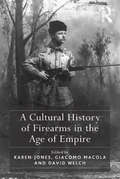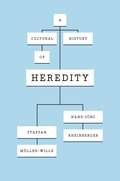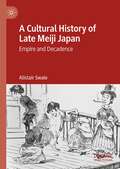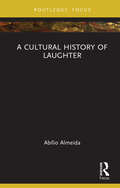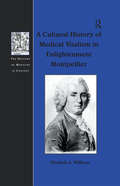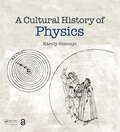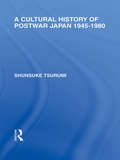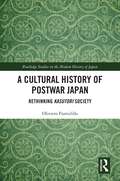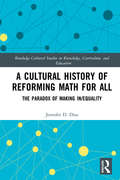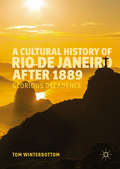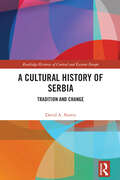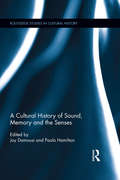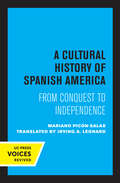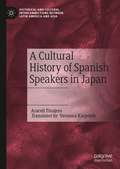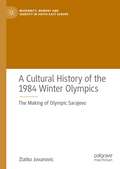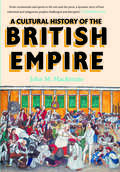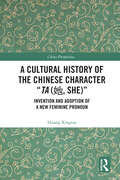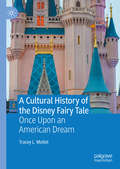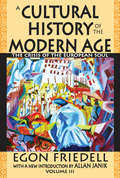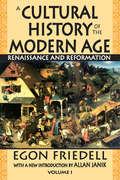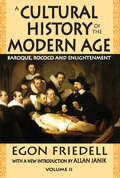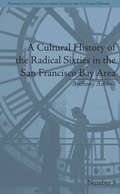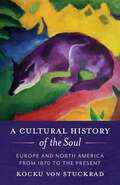- Table View
- List View
A Cultural History of Firearms in the Age of Empire
by Karen JonesFirearms have been studied by imperial historians mainly as means of human destruction and material production. Yet firearms have always been invested with a whole array of additional social and symbolical meanings. By placing these meanings at the centre of analysis, the essays presented in this volume extend the study of the gun beyond the confines of military history and the examination of its impact on specific colonial encounters. By bringing cultural perspectives to bear on this most pervasive of technological artefacts, the contributors explore the densely interwoven relationships between firearms and broad processes of social change. In so doing, they contribute to a fuller understanding of some of the most significant consequences of British and American imperial expansions. Not the least original feature of the book is its global frame of reference. Bringing together historians of different periods and regions, A Cultural History of Firearms in the Age of Empire overcomes traditional compartmentalisations of historical knowledge and encourages the drawing of novel and illuminating comparisons across time and space.
A Cultural History of Heredity
by Hans-Jörg Rheinberger Staffan Müller-Wille&“Thought-provoking…any scientist interested in genetics will find this an enlightening look at the history of this field.&”—Quarterly Review of Biology It was only around 1800 that heredity began to enter debates among physicians, breeders, and naturalists. Soon thereafter, it evolved into one of the most fundamental concepts of biology. Here, Staffan Muller-Wille and Hans-Jorg Rheinberger offer a succinct cultural history of the scientific concept of heredity. They outline the dramatic changes the idea has undergone since the early modern period and describe the political and technological developments that brought about these changes. They begin with an account of premodern theories of generation, showing that these were concerned with the procreation of individuals rather than with hereditary transmission, and reveal that when hereditarian thinking first emerged, it did so in a variety of cultural domains, such as politics and law, medicine, natural history, breeding, and anthropology. The authors then track theories of heredity from the late nineteenth century—when leading biologists considered it in light of growing societal concerns with race and eugenics—through the rise of classical and molecular genetics in the twentieth century, to today, as researchers apply sophisticated information technologies to understand heredity. What we come to see from this exquisite history is why it took such a long time for heredity to become a prominent concept in the life sciences, and why it gained such overwhelming importance in those sciences and the broader culture over the last two centuries.
A Cultural History of Late Meiji Japan: Empire and Decadence
by Alistair SwaleScholarship on Japan’s development from the late nineteenth century to the early twentieth century has, perhaps quite understandably, been dominated by attention given to Japan’s emergence as a world power through a succession of military conflicts, and the burgeoning of a modern literary canon. This book argues that the emergence of empire and high culture needs to be more thoroughly integrated with an awareness of popular culture in urban life, a culture that at times exhibited a less than whole-hearted enthusiasm for the trappings of 'civilization', - a culture that was, in a sense, ‘decadent’. It integrates coverage of popular culture across diverse media and platforms, accentuating the emergence of new modern forms that evolved from the inter-relation between textual, visual and performative traditions such as kōdan and gidayū. The commentary is seasoned with reference to contemporary narratives, aiming to capture more ‘on the street’ perceptions of momentous events such as war and natural disasters, as well as the more arcane or curious media sensations of the moment. These included exposés of scandalous conduct in high places, new fads in popular entertainments and riveting stories of human interest whether it be crime or tragedies of modern urban living.
A Cultural History of Laughter (Morality, Society and Culture)
by Abílio AlmeidaIs laughter a sin? Or is it man’s best medicine? Is laughter now trivialised, mechanised or even weaponised by contemporary media? This book explores the social history of laughter in the West, from classical antiquity to the present day.Engaging with a range of thought from Plato to Nietzsche, it moves from classical to modern thought, considering the changing emotional climate of societies – including the postmodern "dictatorship of happiness" – and the role played by the technological changes of the last century in shaping our interpretation of laughter.A broad, historical study of the physical and emotional aspects of laughter, as well as its social role, A Cultural History of Laughter will appeal to scholars of sociology, history and cultural studies, among other fields of knowledge.
A Cultural History of Medical Vitalism in Enlightenment Montpellier (The History of Medicine in Context)
by Elizabeth A. WilliamsOne of the key themes of the Enlightenment was the search for universal laws and truths that would help illuminate the workings of the universe. It is in such attitudes that we trace the origins of modern science and medicine. However, not all eighteenth century scientists and physicians believed that such universal laws could be found, particularly in relation to the differences between living and inanimate matter. From the 1740s physicians working in the University of Medicine of Montpellier began to contest Descartes's dualist concept of the body-machine that was being championed by leading Parisian medical 'mechanists'. In place of the body-machine perspective that sought laws universally valid for all phenomena, the vitalists postulated a distinction being living and other matter, offering a holistic understanding of the physical-moral relation in place of mind-body dualism. Their medicine was not based on mathematics and the unity of the sciences, but on observation of the individual patient and the harmonious activities of the 'body-economy'. Vitalists believed that Illness was a result of disharmony in this 'body-economy' which could only be remedied on an individual level depending on the patient's own 'natural' limitations. The limitations were established by a myriad of factors such as sex, class, age, temperament, region, and race, which negated the use of a single universal treatment for a particular ailment. Ultimately Montpelier medicine was eclipsed by that of Paris, a development linked to the dynamics of the Enlightenment as a movement bent on cultural centralisation, acquiring a reputation as a kind of anti-science of the exotic and the mad. Given the long-standing Paris-centrism of French cultural history, Montpellier vitalism has never been accorded the attention it deserves by historians. This study repairs that neglect.
A Cultural History of Physics
by Károly SimonyiWhile the physical sciences are a continuously evolving source of technology and of understanding about our world, they have become so specialized and rely on so much prerequisite knowledge that for many people today the divide between the sciences and the humanities seems even greater than it was when C. P. Snow delivered his famous 1959 lecture, "The Two Cultures." In A Cultural History of Physics, Hungarian scientist and educator Károly Simonyi succeeds in bridging this chasm by describing the experimental methods and theoretical interpretations that created scientific knowledge, from ancient times to the present day, within the cultural environment in which it was formed. Unlike any other work of its kind, Simonyi’s seminal opus explores the interplay of science and the humanities to convey the wonder and excitement of scientific development throughout the ages. These pages contain an abundance of excerpts from original resources, a wide array of clear and straightforward explanations, and an astonishing wealth of insight, revealing the historical progress of science and inviting readers into a dialogue with the great scientific minds that shaped our current understanding of physics. Beautifully illustrated, accurate in its scientific content and broad in its historical and cultural perspective, this book will be a valuable reference for scholars and an inspiration to aspiring scientists and humanists who believe that science is an integral part of our culture.
A Cultural History of Postwar Japan: 1945-1980 (Routledge Library Editions: Japan)
by Shunsuke TsurumiShunsuke Tsurumi, one of Japan’s most distinguished contemporary philosophers, continues his study of the intellectual and social history of modern Japan with this penetrating analysis of popular culture in the post-war years. Japanese manga (comics), manzai (dialogues), television, advertising and popular songs are the medium for a revealing examination of the many contradictory forces at work beneath the surface of an apparently uniform and universal culture. The author argues that the iconography of these popular forms has deep and significant implication for the development of Japanese national life in the post-growth years that lie ahead.
A Cultural History of Postwar Japan: Rethinking Kasutori Society (Routledge Studies in the Modern History of Japan)
by Oliviero FrattolilloThis book is a political and cultural history of the early postwar Japan aiming at exploring how the perception and cultural values of everyday life in the country changed along with the rise of the kasutori culture. Such a process was closely tied with both a refusal of the samurai culture and the interwar debate on modernity, and it resulted in a decadent way of life, exemplified by intellectuals such as Sakaguchi Ango. It depicts a short-lived radical cultural and social alternative, one that forced people to rethink their relationship to the kokutai, modernity, social roles, daily practices, and the production of knowledge. The subjectivity and daily practices in those years were more important in shaping the cultural identities of the Japanese than the new public ideology of the nation. This challenges some Euro-American historical notions that the new private sphere has emerged in Japan as an effect of the country’s Americanization, rather than from within it. This work not only looks at the immediate aftermath of WWII from the perspective of Japan, but also tries to rethink Westernization in the light of its global appropriation. This volume is addressed to specialists of Japanese or Asian history, but it will also attract historians of the United States and readers from political and intellectual history, cultural studies, and historiography in general.
A Cultural History of Reforming Math for All: The Paradox of Making In/equality (Routledge Cultural Studies in Knowledge, Curriculum, and Education)
by Jennifer D. DiazWhile many accept that math is a universal, culturally indifferent subject in school, this book demonstrates that this is anything but true. Building off of a historically conscious understanding of school reform, Diaz makes the case that the language of mathematics, and the symbols through which it is communicated, is not merely about the alleged cultural indifference of mathematical thinking; rather, mathematical teaching relates to historical, cultural, political, and social understandings of equality that order who the child is and should be. Focusing on elementary math for all education reforms in America since the mid-twentieth century, Diaz offers an alternative way of thinking about the subject that recognizes the historical making of contemporary notions of inequality and difference.
A Cultural History of Rio de Janeiro after 1889: Glorious Decadence
by Tom WinterbottomThis book studies architecture andliterature of Rio de Janeiro, the "Marvellous City," from the revolution of1889 to the Olympics of 2016, taking the reader on a journey through thehistory of the city. This study offers a wide-ranging and thought-provokinginsight that moves from ruins to Modernism, from the past to the future, fromfutebol to fiction, and from beach to favela, to uncover the surprisingfeature--decadence--at the heart of this unique and seemingly timeless urbanworld. An innovative and in-depth study of buildings, books, and characters inthe city's modern history, this fundamental new work sets the reader in theglorious world of Rio de Janeiro.
A Cultural History of Serbia: Tradition and Change (Routledge Histories of Central and Eastern Europe)
by David A. NorrisThis volume focuses on Serbia’s need to manage change while preserving community identities, a narrative that avoids the common depiction of Serbian culture as a hostile struggle between modernizers supporting foreign models and traditionalists advocating forms of national cultural patrimony.Traditions only function if they are allowed to bend to the necessary modifications demanded by a community’s changing historical circumstances. Tradition and change are two sides of the same coin which Serbia, in its many different incarnations, has experienced over the centuries, protecting its national heritage while borrowing and adapting intellectual and other trends from Byzantine, Ottoman and Western sources. Outside influences have been imposed as a direct result of foreign rule or through more friendly channels of communication, leading to a complex relationship between autochthonous and alien elements in Serbian society and culture. This book argues that the division between the national and international frameworks has often been a false dichotomy, with outside features embedded in domestic symbolic capital and Serbian culture simultaneously determined on local, national, regional and global levels.David A. Norris’s approach offers a new perspective to students, academics and general readers interested in the history of Serbia’s participation in the broad networks of cultural exchange.
A Cultural History of Sound, Memory, and the Senses (Routledge Studies in Cultural History)
by Joy Damousi Paula HamiltonThe past 20 years have witnessed a turn towards the sensuous, particularly the aural, as a viable space for critical exploration in History and other Humanities disciplines. This has been informed by a heightened awareness of the role that the senses play in shaping modern identity and understanding of place; and increasingly, how the senses are central to the memory of past experiences and their representation. The result has been a broadening of our historical imagination, which has previously taken the visual for granted and ignored the other senses. Considering how crucial the auditory aspect of life has been, a shift from seeing to hearing past societies offers a further perspective for examining the complexity of historical events and experiences. Historians in many fields have begun to listen to the past, developing new arguments about the history and the memory of sensory experience. This volume builds on scholarship produced over the last twenty years and explores these dimensions by coupling the history of sound and the senses in distinctive ways: through a study of the sound of violence; the sound of voice mediated by technologies and the expression of memory through the senses. Though sound is the most developed field in the study of the sensorium, many argue that each of the senses should not be studied in isolation from each other, and for this reason, the final section incorporates material which emphasizes the sense as relational.
A Cultural History of Spanish America: From Conquest to Independence
by Mariano Picón-SalasThis title is part of UC Press's Voices Revived program, which commemorates University of California Press’s mission to seek out and cultivate the brightest minds and give them voice, reach, and impact. Drawing on a backlist dating to 1893, Voices Revived makes high-quality, peer-reviewed scholarship accessible once again using print-on-demand technology. This title was originally published in 1962.
A Cultural History of Spanish Speakers in Japan (Historical and Cultural Interconnections between Latin America and Asia)
by Araceli TinajeroBeginning in 1990, thousands of Spanish speakers emigrated to Japan. A Cultural History of Spanish Speakers in Japan focuses on the intellectuals, literature, translations, festivals, cultural associations, music (bolero, tropical music, and pop, including reggaeton), dance (flamenco, tango and salsa), radio, newspapers, magazines, libraries, and blogs produced in Spanish, in Japan, by Latin Americans and Spaniards who have lived in that country over the last three decades. Based on in-depth research in archives throughout the country as well as field work including several interviews, Japanese-speaking Mexican scholar Araceli Tinajero uncovers a transnational, contemporary cultural history that is not only important for today but for future generations.
A Cultural History of Translation in Early Modern Japan
by Rebekah ClementsThe translation of texts has played a formative role in Japan's history of cultural exchange as well as the development of literature, and indigenous legal and religious systems. This is the first book of its kind, however, to offer a comprehensive survey of the role of translation in Japan during the Tokugawa period, 1600-1868. By examining a wide range of translations into Japanese from Chinese, Dutch and other European texts, as well as the translation of classical Japanese into the vernacular, Rebekah Clements reveals the circles of intellectual and political exchange that existed in early modern Japan, arguing that, contrary to popular belief, Japan's 'translation' culture did not begin in the Meiji period. Examining the 'crisis translation' of military texts in response to international threats to security in the nineteenth century, Clements also offers fresh insights into the overthrow of the Tokugawa shogunate in 1868.
A Cultural History of the 1984 Winter Olympics: The Making of Olympic Sarajevo (Modernity, Memory and Identity in South-East Europe)
by Zlatko JovanovicThis book examines the 1984 Sarajevo Winter Olympic Games. It tells the story of the extensive infrastructural transformation of the city and its changing global image in relation to hosting of the Games. Reviewing different cultural representations of Sarajevo in the period from the 1960s to the 1980s, the book explores how the promotion of the city as a future global tourist centre resulted in an increased awareness among its populace of the city’s cultural particularities. The analysis reveals how the process of modernisation relating to hosting of the Olympics provided an opportunity to re-imagine the city as a particularly environmentally progressive city. Placed within the field of studies of late socialism, the book offers important insights into Yugoslav society during the period, including those relating to the country’s unique geopolitical position and its nationalities policies.
A Cultural History of the British Empire: A Cultural History of the British Empire
by John MacKenzieA compelling history of British imperial culture, showing how it was adopted and subverted by colonial subjects around the world As the British Empire expanded across the globe, it exported more than troops and goods. In every colony, imperial delegates dispersed British cultural forms. Facilitated by the rapid growth of print, photography, film, and radio, imperialists imagined this new global culture would cement the unity of the empire. But this remarkably wide-ranging spread of ideas had unintended and surprising results. In this groundbreaking history, John M. MacKenzie examines the importance of culture in British imperialism. MacKenzie describes how colonized peoples were quick to observe British culture—and adapted elements to their own ends, subverting British expectations and eventually beating them at their own game. As indigenous communities integrated their own cultures with the British imports, the empire itself was increasingly undermined. From the extraordinary spread of cricket and horse racing to statues and ceremonies, MacKenzie presents an engaging imperial history—one with profound implications for global culture in the present day.
A Cultural History of the Chinese Character “Ta: Invention and Adoption of a New Feminine Pronoun (China Perspectives)
by Huang XingtaoThis book offers a thorough examination of the history of a Chinese female pronoun – the Chinese character "Ta (她, She)" and demonstrates how the invention and identification of this new word is inextricably intertwined with matters of sociocultural politics. The Chinese character Ta for the third-person feminine singular pronoun was introduced in the late 1910s when the voices of women’s liberation rang out in China. The invention and dissemination of this word not only reflected an ideological gendering of the Chinese script but also provoked heated academic and popular debate well into the 1930s. Thus, the history of Ta provides a prism through which to explore modern Chinese history. The author provides an ambitious and informed examination of how Ta was invented and promoted in relation to the gender equality movement, the politics of neologism, and other domestic elements and international catalysts. This book is the first major work to survey Ta’s creation. It draws on diverse sources, including interviews with eight historians who experienced the popularisation of Ta as youths in the 1930s and 40s. This book will be an essential read for students and scholars of East Asian Studies, Chinese Cultural History, and those who are interested in the history of China.
A Cultural History of the Disney Fairy Tale: Once Upon an American Dream
by Tracey L. MolletThis book charts the complex history of the relationship between the Disney fairy tale and the American Dream, demonstrating the ways in which the Disney fairy tale has been reconstructed and renegotiated alongside, and in response to important changes within American society. In all of its fairy tales of the twentieth and twenty-first centuries, the Walt Disney studios works to sell its audiences the national myth of the United States at any one historical moment. With analyses of films and television programmes such as The Little Mermaid (1989), Frozen (2013), Beauty and the Beast (2017) and Once Upon a Time (2011-2018), Mollet argues that by giving its fairy tale protagonists characteristics associated with ‘good’ Americans, and even by situating their fairy tales within America itself, Disney constructs a vision of America as a utopian space.
A Cultural History of the Modern Age: The Crisis of the European Soul
by Egon FriedellVolume three of A Cultural History of the Modern Age finishes a journey that begins with Descartes in the first volume and ends with Freud and the psychoanalytical movement in the third volume. Friedell describes the contents of these books as a series of performances, starting with the birth of the man of the Modern Age, followed by flowering of this epoch, and concludes with the death of the Modern Age.This huge landscape provides an intertwining of the material and the cultural, the civil and the military, from the high points of creative flowering in Europe to death and emptiness. The themes convey multiple messages: romanticism and liberalism opens the cultural scene, encased in a movement from The Congress of Vienna and its claims of peaceful co-existence to the Franco-German War. The final segment covers the period from Bismarck's generation to World War I. In each instance, the quotidian life of struggle, racial, religious, and social class is seen through the lens of the mighty figures of the period.The works of the period's great figures are shown in the new light of the human search for symbolism, the search for superman, the rise of individualism and decline of history as a source for knowledge. This third volume is painted in dark colors, a foreboding of the world that was to come, of political extremes, and intellectual exaggerations. The author looks forward to a postmodern Europe in which there is a faint glean of light from the other side. What actually appeared was the glare of Nazism and Communism, each claiming the future.
A Cultural History of the Modern Age: Volume 1, Renaissance and Reformation
by Egon FriedellHistorian, philosopher, critic, playwright, journalist, and actor, Egon Friedell was a key figure in the extraordinary flowering of Viennese culture between the two world wars. His masterpiece, A Cultural History of the Modern Age, demonstrates the intellectual universality that Friedell saw as guarantor of the continuity and regeneration of European civilization. Following a brilliant opening essay on cultural history and why it should be studied, the first volume begins with an analysis of the transformation of the Medieval mind as it evolved from the Black Death to the Thirty Years War. The emphasis is on the spiritual and cultural vortex of civilization, but Friedell never forgets the European roots in pestilence, death, and superstition that animate a contrary drive toward reason, refinement, intellectual curiosity, and scientific knowledge. While these values reached their apogee during the Renaissance, Friedell shows that each cultural victory is precarious, and Europe was always in danger of slipping back into barbarism. Friedell's historical vision embraces the whole of Western culture and its development. It is a consistent probing for the divine in the world's course and is, therefore, theology; it is research into the basic forces of the human soul and is, therefore, psychology; it is the most illuminating presentation of the forms of state and society and, therefore, is politics; the most varied collection of all art-creations and is, therefore, aesthetics. Thomas Mann regarded Friedell as one of the great stylists in the German language. Like the works of the great novelist, A Cultural History of the Modern Age offers a dramatic history of the last six centuries, showing the driving forces of each age. The new introduction provides a fascinating biographical sketch of Friedell and his cultural milieu and analyzes his place in intellectual history.
A Cultural History of the Modern Age: Volume 1, Renaissance and Reformation
by Egon FriedellHistorian, philosopher, critic, playwright, journalist, and actor, Egon Friedell was a key figure in the extraordinary flowering of Viennese culture between the two world wars. His masterpiece, A Cultural History of the Modern Age, demonstrates the intellectual universality that Friedell saw as guarantor of the continuity and regeneration of European civilization. Following a brilliant opening essay on cultural history and why it should be studied, the first volume begins with an analysis of the transformation of the Medieval mind as it evolved from the Black Death to the Thirty Years War. The emphasis is on the spiritual and cultural vortex of civilization, but Friedell never forgets the European roots in pestilence, death, and superstition that animate a contrary drive toward reason, refinement, intellectual curiosity, and scientific knowledge. While these values reached their apogee during the Renaissance, Friedell shows that each cultural victory is precarious, and Europe was always in danger of slipping back into barbarism. Friedell's historical vision embraces the whole of Western culture and its development. It is a consistent probing for the divine in the world's course and is, therefore, theology; it is research into the basic forces of the human soul and is, therefore, psychology; it is the most illuminating presentation of the forms of state and society and, therefore, is politics; the most varied collection of all art-creations and is, therefore, aesthetics. Thomas Mann regarded Friedell as one of the great stylists in the German language. Like the works of the great novelist, A Cultural History of the Modern Age offers a dramatic history of the last six centuries, showing the driving forces of each age. The new introduction provides a fascinating biographical sketch of Friedell and his cultural milieu and analyzes his place in intellectual history.
A Cultural History of the Modern Age: Volume 2, Baroque, Rococo and Enlightenment
by Egon FriedellThis is the second volume of Friedell's monumental A Cultural History of the Modern Age. A key figure in the flowering of Viennese culture between the two world wars, this three volume work is considered his masterpiece. The centuries covered in this second volume mark the victory of the scientifi c mind: in nature-research, language-research, politics, economics, war, even morality, poetry, and religion. All systems of thought produced in this century, either begin with the scientifi c outlook as their foundation or regard it as their highest and fi nal goal.Friedell claims three main streams pervade the eighteenth century: Enlightenment, Revolution, and Classicism. In ordinary use, by "Enlightenment" we mean an extreme rationalistic tendency of which preliminary stages were noted in the seventeenth century. Th e term "Classicism", is well understood.Under the term "Revolution" Friedell includes all movements directed against what has been dominant and traditional. Th e aims of such movements were remodeling the state and society, banning all esthetic canons, and dethronement of reason by sentiment, all in the name of the "Return to Nature." Th e Enlightenment tendency might be seen as laying the ground for an age of revolution. Th is second volume continues Friedell's dramatic history of the driving forces of the twentieth century.
A Cultural History of the Radical Sixties in the San Francisco Bay Area (Studies for the International Society for Cultural History #3)
by Anthony AshboltThe San Francisco Bay Area was a meeting point for radical politics and counterculture in the 1960s. Until now there has been little understanding of what made political culture here unique. This work explores the development of a regional culture of radicalism in the Bay Area, one that underpinned both political protest and the counterculture.
A Cultural History of the Soul: Europe and North America from 1870 to the Present
by Kocku von StuckradThe soul, which dominated many intellectual debates at the beginning of the twentieth century, has virtually disappeared from the sciences and the humanities. Yet it is everywhere in popular culture—from holistic therapies and new spiritual practices to literature and film to ecological and political ideologies. Ignored by scholars, it is hiding in plain sight in a plethora of religious, psychological, environmental, and scientific movements.This book uncovers the history of the concept of the soul in twentieth-century Europe and North America. Beginning in fin de siècle Germany, Kocku von Stuckrad examines a fascination spanning philosophy, the sciences, the arts, and the study of religion, as well as occultism and spiritualism, against the backdrop of the emergence of experimental psychology. He then explores how and why the United States witnessed a flowering of ideas about the soul in popular culture and spirituality in the latter half of the century.Von Stuckrad examines an astonishingly wide range of figures and movements—ranging from Ernest Renan, Martin Buber, and Carl Gustav Jung to the Esalen Institute, deep ecology, and revivals of shamanism, animism, and paganism to Rachel Carson, Ursula K. Le Guin, and the Harry Potter franchise. Revealing how the soul remains central to a culture that is only seemingly secular, this book casts new light on the place of spirituality, religion, and metaphysics in Europe and North America today.
